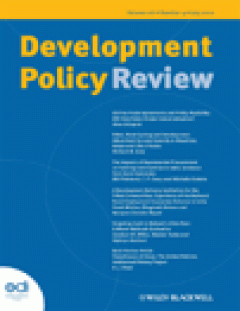Filter by

DPR Debate : Growth Identification and Facilitation: The Role of the State in…
This DPR Debate is based on the contribution by Justin Lin, Chief Economist at the World Bank, and his colleague Célestin Monga, on ‘Growth Identification and Facilitation: The Role of the State in the Dynamics of Structural Change’. The article under consideration is important and timely as it articulates a number of new policy implications from Justin Lin's earlier work on New Structural Econ…
- Edition
- Volume 29, Issue 3, May 2011, pages 259–310
- ISBN/ISSN
- 09506764
- Collation
- -
- Series Title
- Development Policy Review
- Call Number
- -

Poverty Research in a Development Policy Context
This article provides an evaluation of the extent to which science is addressing worldwide poverty and hunger. It is based on the literature contained in the Thomson Reuters' Web of Science Citation Index (1980 to 2008) and focuses on the WOTRO Strategy Plan 2007–2010 of the Netherlands Foundation for the Advancement of Tropical Research, although similar policies from other countries might als…
- Edition
- Volume 29, Issue 3, May 2011, pages 311–330
- ISBN/ISSN
- 09506764
- Collation
- -
- Series Title
- Development Policy Review
- Call Number
- -

Whither Commodity-based Trade?
Market access for livestock products from Africa has traditionally been limited by the presence of certain infectious diseases that pose risks to animal and human health. However, an increasingly discussed option for widening that access is commodity-based trade (CBT) focusing on the health and safety attributes of the product rather than the disease status of the country of origin. There have,…
- Edition
- Volume 29, Issue 3, May 2011, pages 331–357
- ISBN/ISSN
- 09506764
- Collation
- -
- Series Title
- Development Policy Review
- Call Number
- -

Pathways of Technological Change in Developing Countries: Review and New Agenda
This article argues the need for strategic reorientation with regard to the technological advancement of developing countries. The continued relevance of incremental capability-building strategies in manufacturing is questioned by: (i) the emergence of new knowledge areas, some of which require closer links with science; (ii) recognition that past strategies have not solved the poverty problem;…
- Edition
- Volume 29, Issue 3, May 2011, pages 359–380
- ISBN/ISSN
- 09506764
- Collation
- -
- Series Title
- Development Policy Review
- Call Number
- -

A model of intellectual capital management capability in the dynamic business…
This paper discusses the way in which intellectual capital (IC) can be managed to assist organization to overcome dynamic challenges. An intellectual capital management capability (ICMC) model is developed which permits the management of an organization to realize the potential of IC by measuring the maturity level of its IC. The model is consistent with dynamic capability theory, which suggest…
- Edition
- Vol. 8, Number 1, March 2010.pp. 15–23
- ISBN/ISSN
- 14778238
- Collation
- -
- Series Title
- Knowledge Management Research & Practice
- Call Number
- -

Linking social capital to organizational growth
In the current discussion of the intellectual capital, three main themes have been brought up: intangible assets, the dynamic capabilities to create and modify these assets, and the social relationships in which the knowledge processes take place, that is social capital. Within the latter view, knowledge is understood as a socially constructed and shared resource, and the focus is on the charac…
- Edition
- Vol. 8, Number 1, March 2010.pp. 4–14
- ISBN/ISSN
- 14778238
- Collation
- -
- Series Title
- Knowledge Management Research & Practice
- Call Number
- -

TaxoFolk : a hybrid taxonomy–folksonomy classification for enhanced knowled…
Taxonomy is widely used in many of the website and directory navigation schemes for content/knowledge retrieval. However, information or content navigation support through taxonomy is often constrained due to its inability to take into account the full nomenclature and cultural nuances of knowledge seekers. The emergence and increasing adoption of collaborative tagging (social bookmarking) tool…
- Edition
- Vol. 8, No. 1, March 2010.pp. 24–32
- ISBN/ISSN
- 14778238
- Collation
- -
- Series Title
- Knowledge Management Research & Practice
- Call Number
- -

The interplay between individual and collective knowledge : technologies for …
This article presents a framework model that defines knowledge building as a co-evolution of cognitive and social systems. Our model brings together Nonaka's knowledge-creating theory and Luhmann's systems theory. It is demonstrated how collaborative knowledge building may occur – in an ideal situation – within an organisation, when people interact with each other using shared digital artefacts…
- Edition
- Vol. 8 No. 1, March 2010.pp. 33–44
- ISBN/ISSN
- 14778238
- Collation
- -
- Series Title
- Knowledge Management Research & Practice
- Call Number
- -

Software and human agents in Knowledge Codification
In the age of digital networks and databases, gathering data is no longer a differentiating attribute. Instead, the onus is upon creating knowledge and codifying it into the organizational routine. The central theme of this paper is to offer a systematic knowledge codification routine that embodies specific agent attributes and best re-engineering practices. The knowledge process re-engineering…
- Edition
- Vol. 8, No. 1, March 2010.pp. 45–60
- ISBN/ISSN
- 14778238
- Collation
- -
- Series Title
- Knowledge Management Research & Practice
- Call Number
- -

The Inventor game : game-theoretical analysis of knowledge-sharing between in…
Knowledge-sharing has often been analysed by one-shot game models, where the balance between costs and the value of knowledge exchanges for different exchange partners has been calculated. This paper reviews this literature and discusses five of its assumptions: (1) the assumption of homogeneity of knowledge, (2) the assumption of one-shot solutions, (3) the assumption of knowledge as value, (4…
- Edition
- Vol. 8, No. 1, March 2010.pp. 61–75
- ISBN/ISSN
- 14778238
- Collation
- -
- Series Title
- Knowledge Management Research & Practice
- Call Number
- -

Understanding of knowledge management roles and responsibilities : a study in…
Most of the studies in knowledge management (KM) argue for leadership as a vital success factor for any initiative. Top management leadership enables the effective promotion of knowledge sharing by creating an appropriate organisational culture, and making arrangements for corresponding policies and procedures across the organisation to facilitate management of knowledge resources and practices…
- Edition
- Vol. 8 No. 1, March 2010.pp. 76–88
- ISBN/ISSN
- 14778238
- Collation
- -
- Series Title
- Knowledge Management Research & Practice
- Call Number
- -

Global faculty learning community : a case study
This case study provides an exploratory analysis of the Faculty Learning Community (FLC) aimed at encouraging and supporting sharing of teaching experiences among faculty members at Universitas 21 Global (U21G). The analysis reveals a community in the formative stages of evolutionary development. The preliminary results indicate a prevailing pattern of knowledge sharing characterised by low int…
- Edition
- Vol. 8, No. 1, March 2010.pp. 89–98
- ISBN/ISSN
- 14778238
- Collation
- -
- Series Title
- Knowledge Management Research & Practice
- Call Number
- -

The Paradox of Meritocracy in Organizations
In this article, we develop and empirically test the theoretical argument that when an organizational culture promotes meritocracy (compared with when it does not), managers in that organization may ironically show greater bias in favor of men over equally performing women in translating employee performance evaluations into rewards and other key career outcomes; we call this the “paradox of me…
- Edition
- Vol. 55, No. 4 December 2010. pp. 543-576
- ISBN/ISSN
- 00018392
- Collation
- -
- Series Title
- Administration Science Quarterly
- Call Number
- -

Organizing the In-between : The Population Dynamics of Network-weaving Organi…
This article examines the population dynamics and viability of network weavers, which are organizations that provide network relations for others. An analysis of the population dynamics of the intergovernmental organizations (IGOs) that are the basis of the interstate networks that influenced global economic relations, peace, and democracy in the 1815–2000 period shows that IGO founding and fai…
- Edition
- Vol. 55, No. 4 December 2010. pp. 577-605
- ISBN/ISSN
- 00018392
- Collation
- -
- Series Title
- Administration Science Quarterly
- Call Number
- -

Markets, Morals, and Practices of Trade : Jurisdictional Disputes in the U.S.…
This study examines the U.S. commerce in human cadavers for medical education and research to explore variation in legitimacy in trades involving similar goods. It draws on archival, interview, and observational data mainly from New York State to analyze market participants’ efforts to legitimize commerce and resolve a jurisdictional dispute. Building on literature on professions, the study sho…
- Edition
- Vol. 55, No. 4 December 2010. pp. 606-638
- ISBN/ISSN
- 00018392
- Collation
- -
- Series Title
- Administration Science Quarterly
- Call Number
- -

Network Churn : The Effects of Self-Monitoring Personality on Brokerage Dynamics
The apparent stability of social network structures may mask considerable change and adjustment in the ties that make up the networks. In this study, we theorize and test—using longitudinal data on friendship relations from a radiology department located in the Netherlands—the idea that the characteristics of this “network churn” and the resultant brokerage dynamics are traceable to individual …
- Edition
- Vol. 55, No. 4 December 2010. pp. 639-670
- ISBN/ISSN
- 00018392
- Collation
- -
- Series Title
- Administration Science Quarterly
- Call Number
- -

THE IRREPRESSIBLE ROD RHODES : CONTESTING TRADITIONS AND BLURRING GENRES
Rod Rhodes spent 25 years as the Editor of Public Administration before he retired from that role at the end of 2010. These essays in his honour are intended to celebrate the achievement of those 25 years and reflect on his contribution to the worlds of public administration and political science. Rod has now consolidated the standing of the journal as one of the most significant locations for …
- Edition
- Volume 89, Issue 1, March 2011. pages 1–14
- ISBN/ISSN
- 00333298
- Collation
- -
- Series Title
- Public Administration
- Call Number
- -

WAS LOCAL GOVERNANCE SUCH A GOOD IDEA? A GLOBAL COMPARATIVE PERSPECTIVE
The idea of local governance has gained much prominence but can elected local government be sustained in a role as network coordinator alone? To investigate this question this article focuses attention on four societal roles that local government systems undertake. They can support political identity, underwrite economic development, facilitate social welfare provision or act as a lifestyle co-…
- Edition
- Volume 89, Issue 1, March 2011. pages 15–31
- ISBN/ISSN
- 00333298
- Collation
- -
- Series Title
- Public Administration
- Call Number
- -

THE NEW ORTHODOXY : THE DIFFERENTIATED POLITY MODEL
Anthony King (1989, p. 97) argued some time ago that: ‘most of Britain's best political scientists (…) are for some reason journalists'. This is a claim which could only be made by someone who thinks that understanding, or explaining, politics merely revolves around knowing what happens at the centre of power. It neglects the point that facts do not speak for themselves; rather, they have to be…
- Edition
- Volume 89, Issue 1, March 2011. pages 32–48
- ISBN/ISSN
- 00333298
- Collation
- -
- Series Title
- Public Administration
- Call Number
- -

NETWORKS : REIFIED METAPHOR OR GOVERNANCE PANACEA?
This article will discuss the contribution of Rod Rhodes to the research on networks. I will focus on networks as a typology of state/society relations and as a particular form of governance. It is not only here that Rhodes has left his deepest mark; most research on networks still falls in one of the two sub-fields. The typology of policy networks, which he developed with David Marsh more than…
- Edition
- Volume 89, Issue 1, March 2011. pages 49–63
- ISBN/ISSN
- 00333298
- Collation
- -
- Series Title
- Public Administration
- Call Number
- -
 Computer Science, Information & General Works
Computer Science, Information & General Works  Philosophy & Psychology
Philosophy & Psychology  Religion
Religion  Social Sciences
Social Sciences  Language
Language  Pure Science
Pure Science  Applied Sciences
Applied Sciences  Art & Recreation
Art & Recreation  Literature
Literature  History & Geography
History & Geography